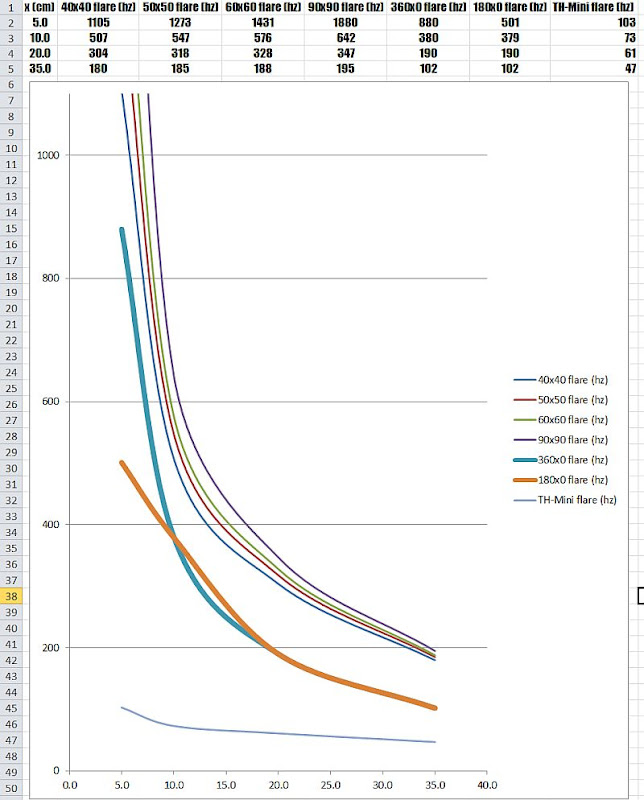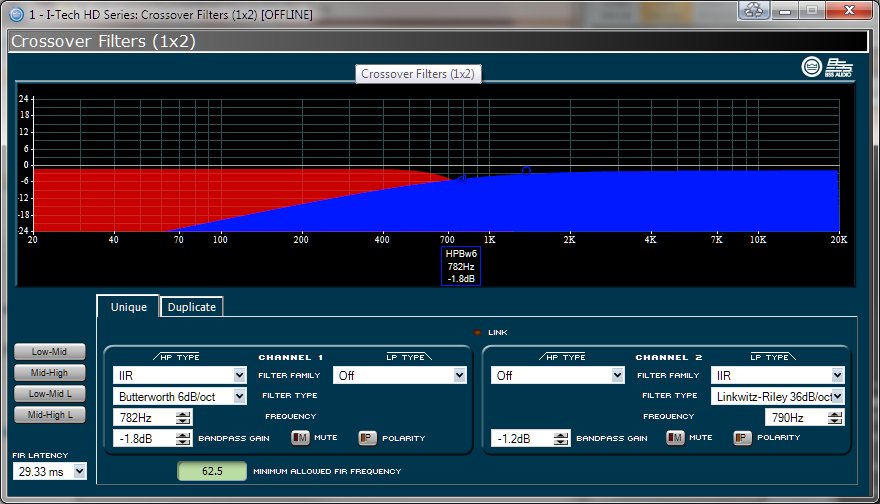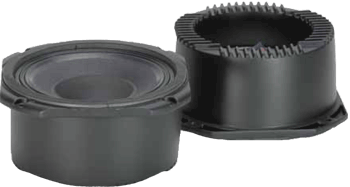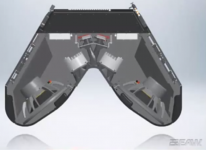Hi Dean,
I have been on the lookout for a suitable mid available locally also. So far there hasn't been much available that follows the basic rule highlighted throughout this thread.
However a nice, affordable 1" CD is available for about $100 each here, the Celestion CDX1745, which is comparable to the more expensive [~$200 here] B&C DE250
Ryan
I have been on the lookout for a suitable mid available locally also. So far there hasn't been much available that follows the basic rule highlighted throughout this thread.
However a nice, affordable 1" CD is available for about $100 each here, the Celestion CDX1745, which is comparable to the more expensive [~$200 here] B&C DE250
Ryan
In post 721 I posted a graph showing the 'local flare rate' of seven different horn geometries. JLH has a good post here talking about the variables:
http://www.diyaudio.com/forums/mult...e-bandpass-mid-unity-horn-15.html#post2404212
In addition to what JLH said, I would add the following:
1) At every point along the pathlength of the horn, the local flare rate is getting lower in frequency Near the throat the flare rate can change a whole octave if you move just five centimeters.

If you look at my graph, the local flare rate looks like a 'hockey stick' around 10cm. IMHO, that's the region you want to avoid; in the 'hockey stick' region you're mids will interfere with your compression driver. So I'd put them between 10 and 20cm down the horn's pathlength.
2) I would personally avoid getting close to the 20cm mark, because you get a notch in the upper passband of the mid due to a reflection
Due to that, I'd argue the 'sweet spot' is around 10cm. I'd reduce that number by two or three centimeters if you're using midranges smaller than 5".
John,
Have you ever posted the raw spreadsheet for this plot? If so and I missed it, I apologize. If you haven't would you consider doing so?
Scott
Maybe I should elaborate!- Is this defined on the egde of the tap-in hole?
@ 1500Hz the area is ~41.62 cm^2. Should the tap-in holes be drilled so that the round egde of the hole (assuming these are round) taps in just at this frequency, i.e. the tap in area is NOT! measured from the center of the tap-in hole?
I don't know if that actually made any sense

Last edited:
Maybe I should elaborate!
@ 1500Hz the area is ~41.62 cm^2. Should the tap-in holes be drilled so that the round egde of the hole (assuming these are round) taps in just at this frequency, i.e. the tap in area is NOT! measured from the center of the tap-in hole?
I don't know if that actually made any sense
I'm still confused. Sorry!
Maybe I should elaborate!
@ 1500Hz the area is ~41.62 cm^2. Should the tap-in holes be drilled so that the round egde of the hole (assuming these are round) taps in just at this frequency, i.e. the tap in area is NOT! measured from the center of the tap-in hole?
I don't know if that actually made any sense
The exact tap in point should be placed in the middle of the slot port. Being off by a few mm is not going to make a big difference at the 1500Hz frequency. You place it at the middle because the speaker sees it as an average cross sectional area.
The exact tap in point should be placed in the middle of the slot port. Being off by a few mm is not going to make a big difference at the 1500Hz frequency. You place it at the middle because the speaker sees it as an average cross sectional area.
Thank you for helping me out, John.
You said it like I meant it
/Thomas
Recently I noticed that Linkwitz went to first order filters for one of the drivers in his LX521, and raised the possibility that phase distortion is real. (Based on what's on his site, he appears to be debating this at the moment.)
http://www.diyaudio.com/forums/multi-way/223454-new-linkwitz-lx521-speakers-7.html#post3240486
And now JBL is using a first order crossover in their new M2. Interesting:

JBL Master Reference Monitor - Page 16
Admittedly, the phase response will depend on the combination of filter *and* acoustic response. So even though it's a first order filter, the phase response will depend on the combination of both.
http://www.diyaudio.com/forums/multi-way/223454-new-linkwitz-lx521-speakers-7.html#post3240486
And now JBL is using a first order crossover in their new M2. Interesting:
JBL Master Reference Monitor - Page 16
Admittedly, the phase response will depend on the combination of filter *and* acoustic response. So even though it's a first order filter, the phase response will depend on the combination of both.
John,
Have you ever posted the raw spreadsheet for this plot? If so and I missed it, I apologize. If you haven't would you consider doing so?
Scott
IIRC, I used hornresp to calculate the flare rate.
So the spreadsheet wouldn't be very useful, because the math is in hornresp.
(IE, you can't just plug in the distance from the throat into a spreadsheet. To get this data I had to literally input the horn data into hornresp, use hornresp to get the local flare rate using the information that JLH provided in this thread, then I posted the number into Excel. So Excel is only being used as a graphing tool; it's not being used to calculate the local flare rate, Hornresp is.)
IIRC, I used hornresp to calculate the flare rate.
So the spreadsheet wouldn't be very useful, because the math is in hornresp.
(IE, you can't just plug in the distance from the throat into a spreadsheet. To get this data I had to literally input the horn data into hornresp, use hornresp to get the local flare rate using the information that JLH provided in this thread, then I posted the number into Excel. So Excel is only being used as a graphing tool; it's not being used to calculate the local flare rate, Hornresp is.)
Rats, I was afraid that might be it. Still thoroughly confused how one converts what appears to be an area rate of change to frequency.
From the AudioXPress Article Horn Theory: An Introduction, Part 1
By Bjørn Kolbrek
"WHAT IS CUTOFF?
Both exponential and hyperbolic horns have a property called cutoff. Below his frequency, the horn transmits nothing,.....You must consider the flare rate of the horn, which is defined as (rate of change of wave-front area with distance)/(wave-front area)."
The article states that it's below this frequency the horn won't be inclined to transmit anything. Yet, in practice just as JLH has said the midrange tapped into synergy horn style speaker really won't go higher in frequency than the flare cutoff frequency calculated by Hornresp at that point. I'm not real sure where I'm making my error, or if people are using flare rate and cutoff frequency interchangeably and shouldn't be, or something else that I've completely missed.
I feel like I'm running in circles with it, so I just built some horns (4 tap placements and more porting variations than I can count) and got pretty decent response out of the drivers. Now to finish the enclosure to see what I have.
Scott
Last edited:
Most people are using flare rate and cutoff frequency interchangeably. A driver tapped into a Synergy style speaker will not play LOWER in frequency than the local flare rate/cutoff frequency. A driver tapped into a Synergy style speaker will normally play up to a frequency where the circumference of the cross sectional area of the tap is equal to one wavelength.
Example: You have a mid tap into the horn where the area is 60cm^2. To find the local flare rate/cutoff frequency you use Horn Response to calculate the length it takes for it to reach 120cm^2 (a doubling of area). Lets say it takes 4cm to go from 60cm^2 to 120cm^2 in our conical horn. Highlight the horn segment in Horn Response and press the E key on your keyboard to change the horn profile from conical to exponential. The flare rate will now be displayed. In this example it should tell you the flare rate is 474.37Hz. This is how low you can expect the mids to play provided there are not issues with your horn build. Now to figure out how high it will play. We can calculate what the circumference of a circle with an area of 60cm^2. It is 27.45cm long. a 1248Hz sound wave is 27.48cm long. Therefore we can expect our mid to play reasonably well between about 470Hz - 1250Hz. One last detail is the cancellation notch. If you space the mids too far down the horn, the notch will over ride everything. If the notch occurs at 1000Hz, than that is high you will get out of the mid.
Example: You have a mid tap into the horn where the area is 60cm^2. To find the local flare rate/cutoff frequency you use Horn Response to calculate the length it takes for it to reach 120cm^2 (a doubling of area). Lets say it takes 4cm to go from 60cm^2 to 120cm^2 in our conical horn. Highlight the horn segment in Horn Response and press the E key on your keyboard to change the horn profile from conical to exponential. The flare rate will now be displayed. In this example it should tell you the flare rate is 474.37Hz. This is how low you can expect the mids to play provided there are not issues with your horn build. Now to figure out how high it will play. We can calculate what the circumference of a circle with an area of 60cm^2. It is 27.45cm long. a 1248Hz sound wave is 27.48cm long. Therefore we can expect our mid to play reasonably well between about 470Hz - 1250Hz. One last detail is the cancellation notch. If you space the mids too far down the horn, the notch will over ride everything. If the notch occurs at 1000Hz, than that is high you will get out of the mid.
Most people are using flare rate and cutoff frequency interchangeably. A driver tapped into a Synergy style speaker will not play LOWER in frequency than the local flare rate/cutoff frequency. ....If the notch occurs at 1000Hz, than that is high you will get out of the mid.
Plus the need to keep the drivers within 1/4 wavelength at crossover...I think I may have a better understanding of the various tradeoffs now than ever before. Thank you!!!
Most people are using flare rate and cutoff frequency interchangeably. A driver tapped into a Synergy style speaker will not play LOWER in frequency than the local flare rate/cutoff frequency. A driver tapped into a Synergy style speaker will normally play up to a frequency where the circumference of the cross sectional area of the tap is equal to one wavelength.
Example: You have a mid tap into the horn where the area is 60cm^2. To find the local flare rate/cutoff frequency you use Horn Response to calculate the length it takes for it to reach 120cm^2 (a doubling of area). Lets say it takes 4cm to go from 60cm^2 to 120cm^2 in our conical horn. Highlight the horn segment in Horn Response and press the E key on your keyboard to change the horn profile from conical to exponential. The flare rate will now be displayed. In this example it should tell you the flare rate is 474.37Hz. This is how low you can expect the mids to play provided there are not issues with your horn build. Now to figure out how high it will play. We can calculate what the circumference of a circle with an area of 60cm^2. It is 27.45cm long. a 1248Hz sound wave is 27.48cm long. Therefore we can expect our mid to play reasonably well between about 470Hz - 1250Hz. One last detail is the cancellation notch. If you space the mids too far down the horn, the notch will over ride everything. If the notch occurs at 1000Hz, than that is high you will get out of the mid.
How hard and fast are these rules, how much variance can I expect in built performance? In my horn there is very good agreement at the high end, right on the button at 1200Hz. At the low end however, the agreement isn't very good at all. Hornresp says it's 600hz...and I get good response an octave lower than that, to 300Hz.
Scott
How hard and fast are these rules, how much variance can I expect in built performance? In my horn there is very good agreement at the high end, right on the button at 1200Hz. At the low end however, the agreement isn't very good at all. Hornresp says it's 600hz...and I get good response an octave lower than that, to 300Hz.
Scott
Nothing set in stone. They are just minimal guidelines. If your local area flare rate is high, but you are getting response below what you calculated, then most likely the mids' resonance is propping things up in the lower frequencies.
An externally hosted image should be here but it was not working when we last tested it.
An externally hosted image should be here but it was not working when we last tested it.
An externally hosted image should be here but it was not working when we last tested it.
Here's a new box from EAW that is similar to the Unity horns, Synergy Horns, and VTC Paralines. (The Yorkville Paralines are a bit different because the mids *don't* use a physical filter.)
Here's a video on it:
Meet Anya - YouTube
Here's some features (which should sound familiar):
1) High frequencies at the horn throat
2) midranges tapped in close to the highs
3) lows at the edge of the horn
4) Diffraction treatment at the horn mouth (this is nothing new)
5) Fourteen compression drivers at the throat. (Can you say "Paraline?")
When you see other companies try to make something as close to one of your products without infringing on your patent, you know you have the better design. Danley absolutely smashes all the other speaker technology on the market. I've done three listening demos with Danley Synergy horns and other brands of PA speakers. It takes less than 5 seconds to hear which one is superior. I'm curious how close EAW has came with the Anya. Either way, with all its special custom drivers, I don't see how they could compete on price unless they set out to undercut Danley at a loss for a long while.
When you see other companies try to make something as close to one of your products without infringing on your patent, you know you have the better design. Danley absolutely smashes all the other speaker technology on the market. I've done three listening demos with Danley Synergy horns and other brands of PA speakers. It takes less than 5 seconds to hear which one is superior. I'm curious how close EAW has came with the Anya. Either way, with all its special custom drivers, I don't see how they could compete on price unless they set out to undercut Danley at a loss for a long while.
Interestingly enough, I found out a couple things from the video:
1) There isn't anything special at the throat; it's just a plain ol' array of neodymium compression drivers
2) The driver in the video appears to be the Celestion CDX1-1425, but with a truncated motor. Basically it's been narrowed so that they can fit together more closely
3) According to the video, 14 of the Celestions had an output level that's equivalent to six 'conventional' compression drivers. Considering that the diaphragm and the voice coil are much smaller, this sounds about right.
Kinda cool that the Celestion is getting some love though; I *do* find that it sounds 'sweeter' than my B&Cs and the Dayton D250P clone.
Midrange appears to be six of the RCF M8N301s:

$1800 for six :O
Last edited:
- Home
- Loudspeakers
- Multi-Way
- Suitable midrange cone, for bandpass mid in Unity horn.

